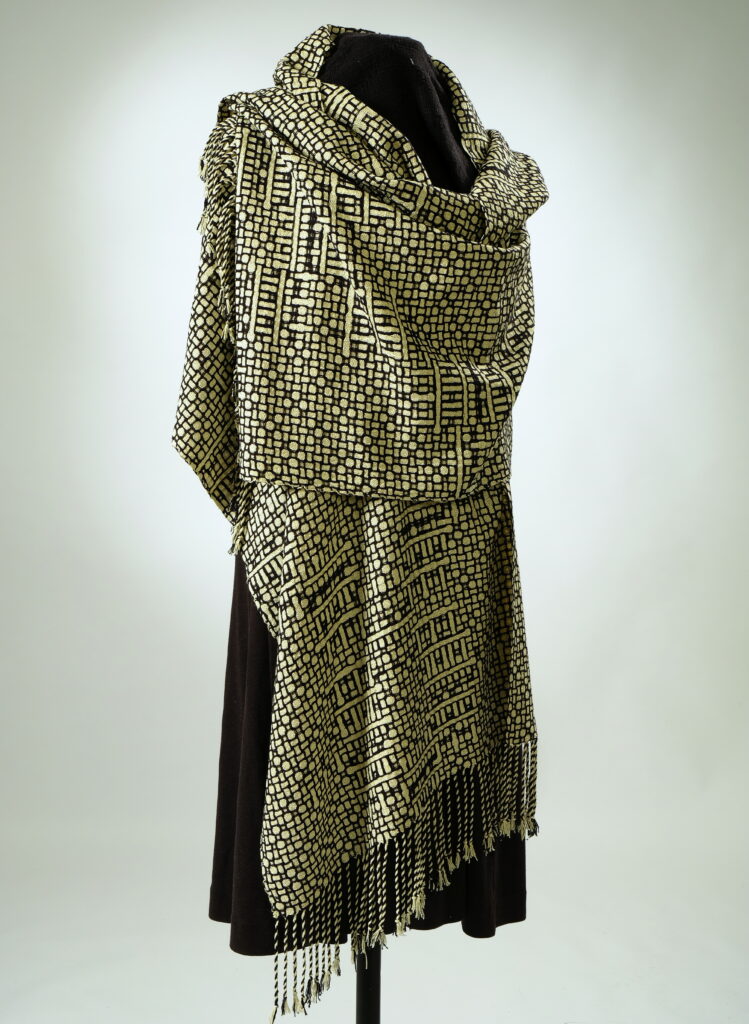
The original Mosaic scarves and shawls have been popular since I started weaving them, and it’s always interesting to expand on an existing pattern. Here’s the story of Mosaic Plus.
The idea for Mosaic Plus started with a local customer who bought a black and white Mosaic shawl a few years ago. She wears it frequently, often with a black and white coat. She really loves it and it suits her, but one day she asked me if I could make her another one but bigger. The Mosaic shawl is 14” wide, a size in between my scarves and the usual 19” wide shawls. I thought an extra wide version was a good idea. I wasn’t going to make exactly the same pattern in a larger size, and this was going to be an interesting project.
Fall is the time of year when I design a lot of new work to be featured in February. The Baltimore American Craft Council show is where wholesale buyers from stores come looking for new and exciting work. In my yearly cycle, I start new designs in the fall, and use my fall shows to display the new work and gauge response. If a pattern is good, I make it on at least three different warps to be able to offer a range of colors to both wholesale and retail customers.
The challenge was to create a piece that was unmistakably in the Mosaic family, but different. I came up with spreading out the Mosaic threading onto all 32 harnesses of my Toika loom. To accomplish this I threaded the 8 harness pattern of Mosaic in four groups, equaling 32. This would be a versatile threading that I could weave all sorts of different ways, depending on what my customer liked. Any of these 4 groups of 8 harness Mosaic threadings could be woven as Mosaic or another way.
For those who are new to weaving, you need both a threading and a treadling to make a pattern. It’s sort of like the X and Y axes in math. Treadling is the weaving part of the pattern, threads going across with a shuttle. This is the X- axis and you can change it as you go while weaving the fabric. Threading is how the warp is arranged, threads going the long way up and down, the Y-axis. Once a warp has its threading, this can’t be changed; all the shawls on this warp have the same Y axis. Again, variation comes with the treadling, or what could be called the order of weaving. With all these blocks, I can weave a certain way to make the Mosaic pattern, or I can weave it in infinite other ways and produce other patterns. I decided to call this spread out Mosaic threading Mosaic Plus.
Unfortunately, this design work demanded mental energy and time that I didn’t have available until after ACC Baltimore. I did an experimental scarf that I liked very much. It’s Mosaic Plus but with only two blocks, 16 harnesses, and it was well received at Baltimore. When I got home, I started working on the shawl. I arranged the blocks in a big V, and completed 5 variations. This was at the beginning of our social distance lifestyle, so instead of getting together with my customer I left them on her porch and retrieved them the next day. She picked one with a big diamond motif. In this one the warp order was echoed and reversed, so the big V became diamonds. Other shawls have blocks arranged differently, but they are all Mosaic with new patterns added. You can see me weaving one here.
I have these in stock in my webstore, and will miss showing them in person this season. One is different on either side, and others have blocks in various arrangements. I made shawls in extra dark colors, some with warm colors, some with cool colors. So far, I’ve done more scarves in black and white and soft colors, and am looking forward to making them in vibrant colors.
Loved reading about your process for “broadening” the mosaic pattern! Hope you are doing well, safe and secure! Miss seeing you at shows and chatting during down time. My beadwork is morphing and I have added some textile work in the Judaica series. Your creativity is an inspiration for me!
Now wash your hands and stay safe!!